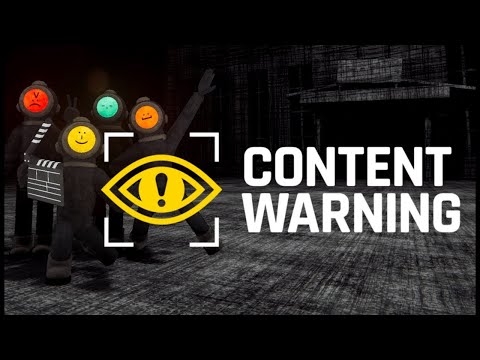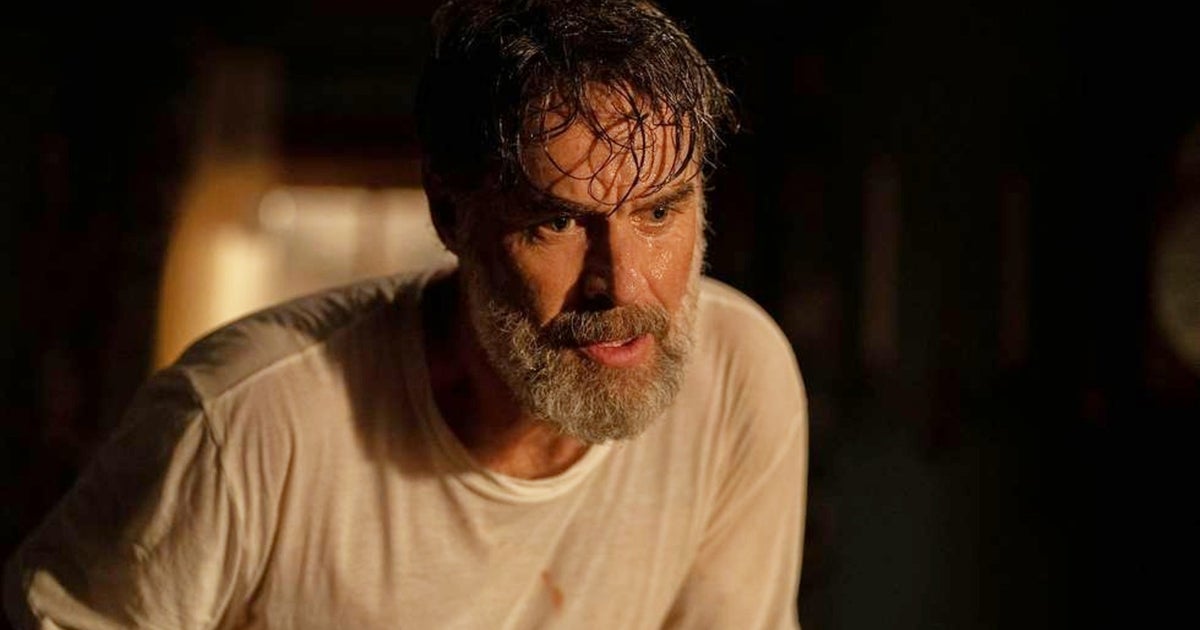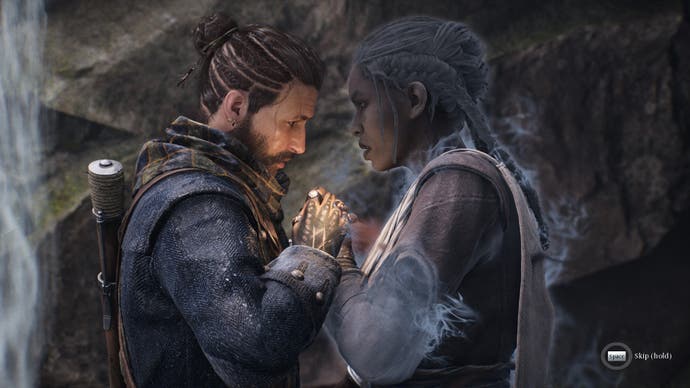[ad_1]
The second part of the long-awaited Final Fantasy 7 remake trilogy is finally here. Final Fantasy 7 Rebirth releases today, an expansive RPG that is perhaps this year’s most significant PS5 console exclusive. We took a quick look at the first few hours in a piece last week, but with all embargo restrictions now removed, now it’s time to crack open the full game and see what’s under the hood. How does the Unreal Engine 4-powered Rebirth take advantage of PS5 hardware? What are the enhancements over Remake? And are there any unexpected visual follies along the way?
Let’s start with what Final Fantasy 7 Rebirth does well and that begins with its excellent cutscenes. These are bombastic, beautifully-directed sequences that provide stunning views of near-CGI level character models in a mix of expository and action scenes. The level of visual quality achieved here is very impressive, and the cinematics are often outstanding. That was true of 2020’s Final Fantasy 7 Remake as well – so what’s changed? Character designs have been tweaked quite a bit for these sequences, with higher grade – and subtly more realistic – modeling.
Skin is more detailed with better-defined specular highlights, while hair rendering is significantly improved. The card-based hair system is less angular and possesses more fine detail, with less dithering and break-up. There’s more obvious light occlusion and self-shadowing, looking shinier than its Remake counterpart. The cutscene lighting has also been improved, often going for cinematic three-point lighting setups that bring the characters into sharper relief against backgrounds. There’s effective indirect lighting in these scenes too, with obvious light bounce from reflective surfaces like sand.
 Final Fantasy 7 Rebirth – PlayStation 5 – The FULL Digital Foundry Tech Review
Final Fantasy 7 Rebirth – PlayStation 5 – The FULL Digital Foundry Tech Review
Though subtle in isolation, these upgrades give the cutscenes a more consistently high-quality appearance. Rebirth’s cutscenes are some of the most visually captivating sequences I’ve seen to date in a video game, with fidelity and animation that easily beat a lot of older CGI, like the Advent Children CG film from 2005. A handful of the game’s cutscenes are still presented with offline CGI however, and these do still offer far higher fidelity than the real-time graphics can achieve, with perfect reflections, great indirect lighting, and beautifully flowing cloth and hair. Rebirth’s real time sequences aren’t particularly close but still look great in their own right.
The game’s action combat is another high point. These battles are a flurry of GPU-driven particles and smoothly-animated combat moves. The camera tends to zoom out a bit more than in Remake and we often see somewhat larger fights with bigger and more numerous foes, but beyond that it’s broadly similar to the experience we had before. The combat is still a high point, and the default action mode strikes a good balance between reaction-based real-time combat moves and slow-motion tactics.
I think Rebirth very effectively handles its more naturalistic environments as well. The polygonal density and level of ground clutter here is solid – and definitely up to expectations for a current-gen game. There’s a lot of nice incidental details in Rebirth’s open-world segments, which seem to have been partly enabled by the use of the PS5’s primitive shader functionality, as the developers have reported.
Relative to Remake, there’s a big boost in the basic fidelity of these more naturalistic environments. Plus – and perhaps more importantly – Remake doesn’t actually have any truly open areas, with the map featuring a more tightly constrained scope. These wide-open gameplay spaces are new for Rebirth. On top of that, distant detail is made of real geometry, unlike Remake, which often resorted to 2D art.
Rebirth’s cities are also worth commenting on. Rebirth has expansive and dense city environments, with plenty of civilians scurrying about and lots of geometric and texture detail. Remake is quite limited by comparison, again with limited, corridor-like towns and cities that feel a little artificial. Rebirth effectively takes the Final Fantasy 7 Remake formula to work within a more expansive setting, and that’s where I think we’ve seen the most technical progress. The broader scope – plus the improvements to character rendering in cutscenes – are the basic enhancements here.
Unfortunately, there are some areas where Rebirth is just treading water relative to its four-year old predecessor – and quite a few spots where we’ve actually seen a step back. Environmental lighting tends to be a serious pain point here. To be fair, many environments look perfectly fine – including the game’s cities, which can exhibit decent precalculated lighting, and some of the larger open-world spaces, which look fine while relying more heavily on real-time techniques. Some of the interiors can look quite nice as well, at least when judged from a distance.

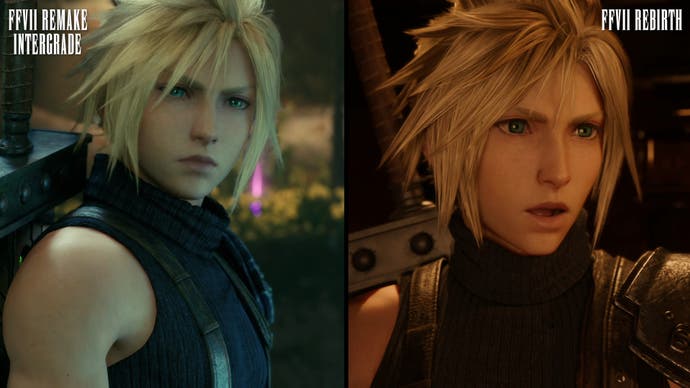
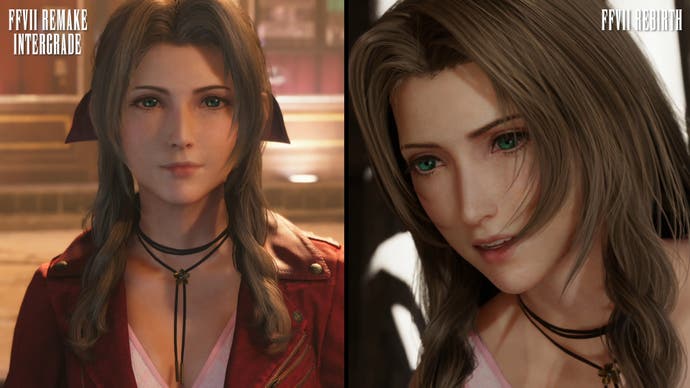
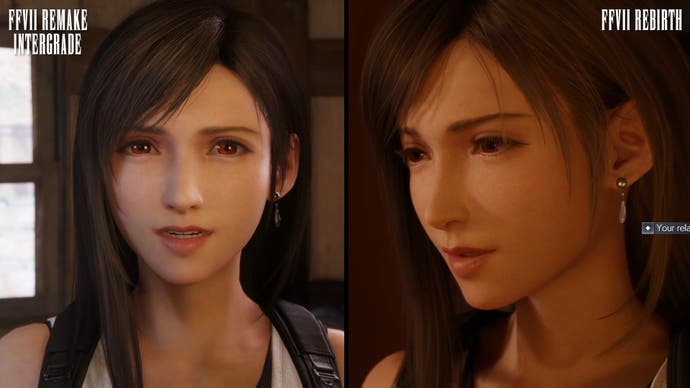
The problems really emerge when we start examining some of the game’s models up close. Complex structures would stand to benefit from improved precalculated lighting to look good, or some kind of real-time traced lighting. Instead, Rebirth presents these areas almost without any lighting detail at all, or with basic non-shadow casting lights. It often doesn’t look great, making the environment look like just a bunch of models jammed together. For a big budget current-gen game, Rebirth can look a little baffling at times. High fidelity and consistent lighting is a cornerstone of current-gen tech, and even without ray-traced GI we would expect a better result here.
That becomes especially clear if we take a look back at Remake. Remake’s baked lighting wasn’t always of the highest fidelity, but it did a pretty good job of simulating global illumination within more constrained spaces, and smaller objects generally looked appropriately grounded and shaded within the world. That’s just not the case much of the time in Rebirth, with worse lighting in typical play.
There are other lighting problems too. Rebirth’s shadows are generally at a very low resolution. There is a high-res shadow cascade at comically close distances to the player camera during gameplay, and the shadow resolution during cutscenes is generally fine, but most shadows during gameplay have a lot of breakup and aliasing. Final Fantasy 7 Remake had higher-res shadows – especially in its Intergrade iteration, which boosted shadow res somewhat for PS5 consoles and PCs. I’m not one to harp on low-res shadows usually, but the quality difference here is pretty profound. It’s hard to believe that lowering shadow resolution to this level is worth it, relative to just using a bit more dynamic res in the image.


Low resolution textures can also be problematic. Of course, FF7 Remake had a lot of issues with texturing in its PS4 incarnation, but Intergrade on PS5 mostly solved these issues. For Rebirth though, there’s a bizarre mixture of low and high resolution assets. Most of the dodgy texture work comes in the Mount Nibelheim ascent in chapter one, which has a lot of textures that need improvement. You will spot the occasional low-res asset from time to time elsewhere, but the game’s first stage has the lion’s share of texturing issues.
Rebirth also has problems with traversal animations. The environment has a lot of rocky outcroppings and the like for the characters to traverse, and their animations when presented with an obstacle look unconvincing. Expect stilted, jerky jumps, and bizarre looking animation when Cloud or another playable character blasts through an obstacle at full speed. Barrett’s climbing animations also look rather physically implausible, though I’m not sure how a one-armed person is supposed to make these leaps.
Finally, there are a couple other things I wanted to touch on. The water generally looks fine from a distance – though the screen-space reflections can be a little annoying as there are no effective cubemap fallbacks. Water in Rebirth isn’t really interactive though, with no geometric or even normal-mapped ripples to trail the player. Splashing around kicks up sprites, but the actual water surface remains quite flat-looking.
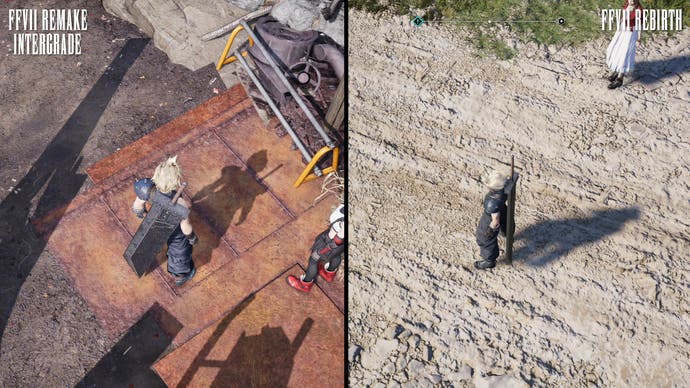
Additionally, there’s no animated collision between the player character and foliage. Cloud simply passes through the foliage, with zero apparent reaction from the bushes and leaves. This isn’t a big issue necessarily, but the first Rebirth trailer did feature foliage collision, which looked like touch bending. In the final game this is totally absent.
Don’t get me wrong – Final Fantasy 7 Rebirth is a generally good-looking game that can look superb in its best moments. However, the title has some obvious visual flaws, primarily with lighting, that in some cases make it less appealing than its four-year-old predecessor. It’s a larger, and often improved visual experience over that game, but these concessions are annoying.
Rebirth offers two visual modes – a graphics mode, which targets 30fps, and a performance mode which targets 60fps. Underlying visual settings appear to be a match here, so you’re getting identical shadows, draw distances, and all the rest of it as far as I can tell. Resolution for the performance mode averages at around 1152p, while the graphics mode is usually at or near 4K, with both modes employing dynamic resolution. That’s nothing particularly special, but there is a very odd quirk with the performance mode. The game doesn’t upscale using a typical bicubic or bilinear method, but instead seems to double the pixels using a nearest neighbour technique or something similar, albeit with a slightly soft final resolve. It’s noticeably blocky and still doesn’t look much sharper than more conventional scaling methods.
I did try setting the PS5’s resolution to 1440p output in the system settings, and the blockiness largely disappeared. It may still be scaling down from that 4K output though, as taking the original 4K output and doing a bilinear scale to 1440p produces a similar enough result. Still, it might be worth considering for those who really can’t stand the image resolve in performance mode. Unfortunately, the relatively low resolution in performance mode – likely combined with some low-res post-processing or another visual bugbear – means that Rebirth is a lot softer than Remake when targeting 60fps. I thought Remake looked solid with its 1512p typical resolution in performance mode, but Rebirth really doesn’t hold up well on a 4K set with the same visual options and requires improvement.
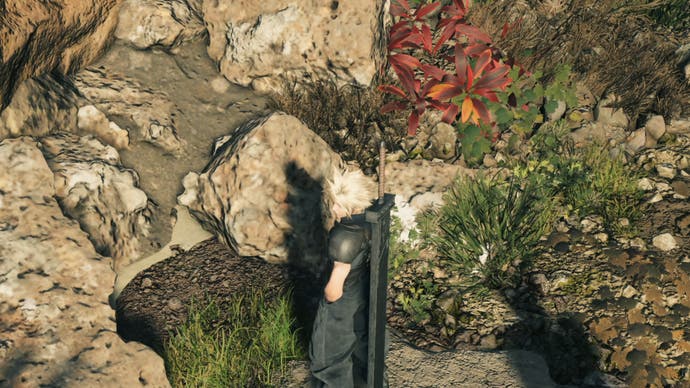

The graphics mode generally looks clean and sharp on a 4K set, with a crisp appearance in most content, though it can seem just a touch soft at times. I did notice a bit of ghosting as well, but it’s otherwise a good image resolve. Again, I do wish camera-based motion blur was added. Per-object blur is enabled at all times, but the lack of camera-based blur makes the graphics mode look unnecessarily choppy. Interestingly, camera-based blur is also absent in cutscenes, which is a change from Remake.
At least the graphics mode does hold a very stable 30fps. It’s basically a locked 30fps, with a dropped frame or 16ms frame very occasionally disrupting that 30fps line. I spent most of my time playing in this mode and it does provide a consistent experience, in combat, traversal, and cutscenes alike. The 60fps performance mode is wobblier. It does stick to 60fps a healthy majority of the time, but as the game progresses the frame-rate can drop into the 50-60fps region during GPU-heavy moments, eg screen-filling particular effects in a battle. Elsewhere, the game is typically a close-to-locked 60fps, with just the occasional dropped frame or two in the mix every so often. Nibelheim also exhibited frame-rate issues in my testing.
As an aside, loading performance in Rebirth is very good – just like it was in Intergrade. Typical loads last about five to six seconds here, which is nice if you’re fast travelling or hopping around from save to save for some reason. There are no loading screens during the game itself either, except of course for fast travel.
 Final Fantasy 7 Rebirth on PS5 – DF Tech Breakdown – Quality/Performance Modes + More
Final Fantasy 7 Rebirth on PS5 – DF Tech Breakdown – Quality/Performance Modes + More
Final Fantasy 7 Rebirth has some impressive visual strengths – but some unfortunate visual lows as well. You get beautiful cutscene sequences and a greatly expanded world, but have to tolerate some questionable lighting, low-res textures, and poor image quality in performance mode. It’s a curiously uneven visual experience, which I think is put into stark contrast by the last major Final Fantasy title – last year’s Final Fantasy 16.
FF16 had great baked lighting, extremely detailed assets and stunning combat. It essentially “solved” typical shadowmap issues using a novel shadowing technique that allowed for very fine detail and a beautiful variable penumbra effect. Its cutscenes were beautiful as well, showcasing an excellent physically-based materials pipeline and super high fidelity characters. Its environments also had very dense geometric detail. FF16 was one of the very best looking games of last year, and I think on the whole it’s quite a bit more visually accomplished than Rebirth.
FF16 was achieved on a custom engine developed around the needs of the title. I wouldn’t chalk all of Rebirth’s issues to Unreal Engine 4, but this isn’t necessarily the best engine for lighting larger environments. I hope Square-Enix will be migrating to more current-gen oriented tech for the final FF7 remake trilogy entry, perhaps Epic’s Unreal Engine 5, because the visual outcomes here are more mixed than I would have expected. Tech like Lumen would be hugely transformative here I think, if used appropriately.
So, technically the results just aren’t quite up to expectations, even if individual pieces of the game’s visual makeup still definitely impress. As a game though, fans of Remake will find a lot to like here. I think its critical acclaim is well-deserved, even if the somewhat intrusive minigames were a little annoying. It does a great job reimagining the middle section of the original title, while expanding the action combat that felt so fresh in Remake. I loved Remake, and while this isn’t quite as much to my tastes, it’s certainly a very effective sequel. Rebirth is without a doubt worth a playthrough for Final Fantasy fans, but its visual output is more inconsistent than I’d like. It’s a good-looking title, just one that arrives with certain key caveats.
[ad_2]
Source link

